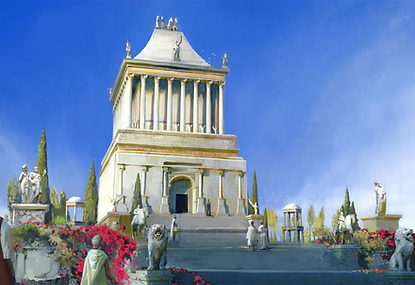
Mausoleum at Halicarnassus
c. 350 BCE, Turkey

Thinking through Alfred Gell (1945-1997)’s Art and Agency & The Technology of Enchantment
In Gell’s framework, the Mausoleum is not a passive monument, but a performative apparatus of posthumous agency. Erected by Artemisia II for her husband Mausolus (a satrap of the Persian Empire), the monument lends us more than its name (the origin of the word “mausoleum”)—it becomes a paradigmatic case of art as social technology, in which architecture performs the function of extending personal charisma beyond death.
Gell insists that artworks are not merely representational but are “indexical signs”—traces that materially link makers, patrons, and viewers across time. In this light, the Mausoleum functions as an index of royal authority, grief, conquest, and divinity, solidified in a structure so powerful in visual and spatial rhetoric that it turned death into a spectacle of statecraft.
Let us consider its enchantment. Standing approximately 45 meters high, crowned with a quadriga (four-horse chariot) statue, it synthesized Hellenistic, Lycian, and Egyptian architectural languages. The layers of ornamentation—massive reliefs of gods, battles, and ceremonial processions—enfold the viewer in a theater of afterlife triumph. Here, the dead Mausolus is not entombed but mythologized, circulating as an aesthetic agent in the political imagination of Anatolia and the Achaemenid world.
In Gellian terms, the Mausoleum is a distributed person. It becomes Mausolus himself—a proxy-body—a prosthetic presence that commands respect, guides governance, and compels remembrance. This “distributed agency” means that Mausolus is not merely remembered; he acts through the architecture. Gell’s model destabilizes the boundary between person and thing, and here, the monument is Mausolus.
Moreover, the building is a form of aesthetic deterrence. Just as Gell discusses Polynesian tattoos or intricate carving as deterrents to violence (by stunning the perceiver), the Mausoleum's grandiosity deterred rebellion. It radiated sovereign energy, asserting that Mausolus, though dead, remained unassailable.
Lastly, the Mausoleum’s influence on subsequent funerary architecture—from Hadrian’s Tomb to Lenin’s Mausoleum—illustrates Gell’s point that artworks propagate agency across networks. This is not a singular tomb but a memetic artifact, whose very idea replicates power in space and time.